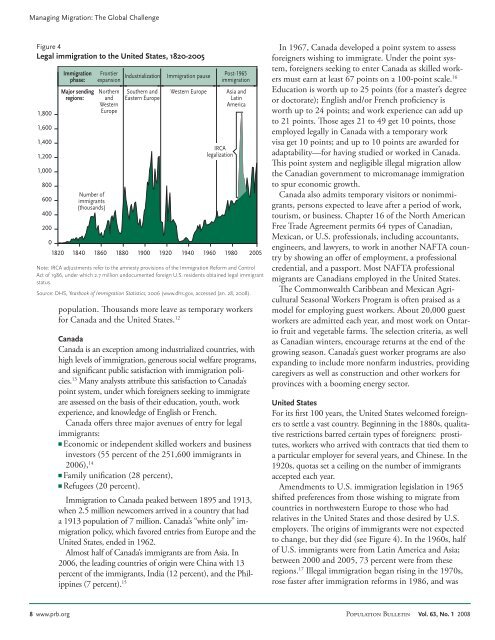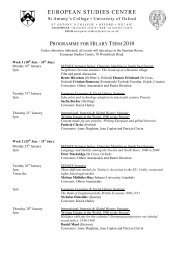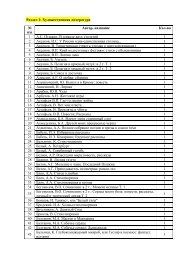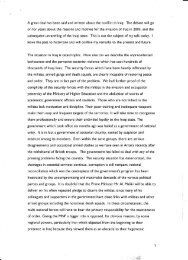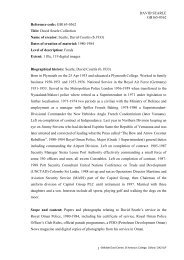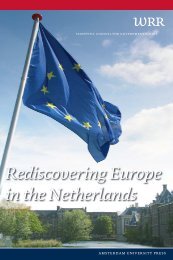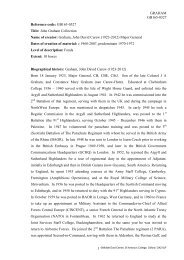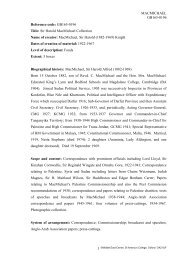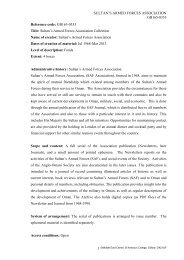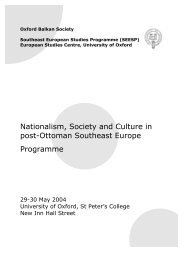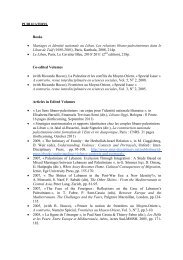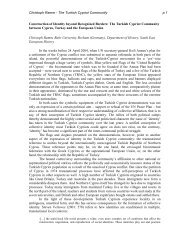Managing Migration: The Global Challenge, Population Bulletin, Vol ...
Managing Migration: The Global Challenge, Population Bulletin, Vol ...
Managing Migration: The Global Challenge, Population Bulletin, Vol ...
Create successful ePaper yourself
Turn your PDF publications into a flip-book with our unique Google optimized e-Paper software.
<strong>Managing</strong> <strong>Migration</strong>: <strong>The</strong> <strong>Global</strong> <strong>Challenge</strong><br />
Figure 4<br />
Legal immigration to the United States, 1820-2005<br />
,<br />
,<br />
,<br />
,<br />
,<br />
<br />
<br />
<br />
<br />
<br />
Immigration<br />
phase:<br />
Major sending<br />
regions:<br />
Number of<br />
immigrants<br />
(thousands)<br />
Frontier<br />
expansion Industrialization Immigration pause Post-<br />
immigration<br />
Northern<br />
and<br />
Western<br />
Europe<br />
Southern and<br />
Eastern Europe<br />
Western Europe<br />
IRCA<br />
legalization<br />
Asia and<br />
Latin<br />
America<br />
<br />
Note: IRCA adjustments refer to the amnesty provisions of the Immigration Reform and Control<br />
Act of 1986, under which 2.7 million undocumented foreign U.S. residents obtained legal immigrant<br />
status.<br />
Source: DHS, Yearbook of Immigration Statistics, 2006 (www.dhs.gov, accessed Jan. 28, 2008).<br />
population. Thousands more leave as temporary workers<br />
for Canada and the United States. 12<br />
Canada<br />
Canada is an exception among industrialized countries, with<br />
high levels of immigration, generous social welfare programs,<br />
and significant public satisfaction with immigration policies.<br />
13 Many analysts attribute this satisfaction to Canada’s<br />
point system, under which foreigners seeking to immigrate<br />
are assessed on the basis of their education, youth, work<br />
experience, and knowledge of English or French.<br />
Canada offers three major avenues of entry for legal<br />
immigrants:<br />
n Economic or independent skilled workers and business<br />
investors (55 percent of the 251,600 immigrants in<br />
2006), 14<br />
n Family unification (28 percent),<br />
n Refugees (20 percent).<br />
Immigration to Canada peaked between 1895 and 1913,<br />
when 2.5 million newcomers arrived in a country that had<br />
a 1913 population of 7 million. Canada’s “white only” immigration<br />
policy, which favored entries from Europe and the<br />
United States, ended in 1962.<br />
Almost half of Canada’s immigrants are from Asia. In<br />
2006, the leading countries of origin were China with 13<br />
percent of the immigrants, India (12 percent), and the Philippines<br />
(7 percent). 15<br />
In 1967, Canada developed a point system to assess<br />
foreigners wishing to immigrate. Under the point system,<br />
foreigners seeking to enter Canada as skilled workers<br />
must earn at least 67 points on a 100-point scale. 16<br />
Education is worth up to 25 points (for a master’s degree<br />
or doctorate); English and/or French proficiency is<br />
worth up to 24 points; and work experience can add up<br />
to 21 points. Those ages 21 to 49 get 10 points, those<br />
employed legally in Canada with a temporary work<br />
visa get 10 points; and up to 10 points are awarded for<br />
adaptability—for having studied or worked in Canada.<br />
This point system and negligible illegal migration allow<br />
the Canadian government to micromanage immigration<br />
to spur economic growth.<br />
Canada also admits temporary visitors or nonimmigrants,<br />
persons expected to leave after a period of work,<br />
tourism, or business. Chapter 16 of the North American<br />
Free Trade Agreement permits 64 types of Canadian,<br />
Mexican, or U.S. professionals, including accountants,<br />
engineers, and lawyers, to work in another NAFTA country<br />
by showing an offer of employment, a professional<br />
credential, and a passport. Most NAFTA professional<br />
migrants are Canadians employed in the United States.<br />
<strong>The</strong> Commonwealth Caribbean and Mexican Agricultural<br />
Seasonal Workers Program is often praised as a<br />
model for employing guest workers. About 20,000 guest<br />
workers are admitted each year, and most work on Ontario<br />
fruit and vegetable farms. <strong>The</strong> selection criteria, as well<br />
as Canadian winters, encourage returns at the end of the<br />
growing season. Canada’s guest worker programs are also<br />
expanding to include more nonfarm industries, providing<br />
caregivers as well as construction and other workers for<br />
provinces with a booming energy sector.<br />
United States<br />
For its first 100 years, the United States welcomed foreigners<br />
to settle a vast country. Beginning in the 1880s, qualitative<br />
restrictions barred certain types of foreigners: prostitutes,<br />
workers who arrived with contracts that tied them to<br />
a particular employer for several years, and Chinese. In the<br />
1920s, quotas set a ceiling on the number of immigrants<br />
accepted each year.<br />
Amendments to U.S. immigration legislation in 1965<br />
shifted preferences from those wishing to migrate from<br />
countries in northwestern Europe to those who had<br />
relatives in the United States and those desired by U.S.<br />
employers. <strong>The</strong> origins of immigrants were not expected<br />
to change, but they did (see Figure 4). In the 1960s, half<br />
of U.S. immigrants were from Latin America and Asia;<br />
between 2000 and 2005, 73 percent were from these<br />
regions. 17 Illegal immigration began rising in the 1970s,<br />
rose faster after immigration reforms in 1986, and was<br />
8 www.prb.org <strong>Population</strong> <strong>Bulletin</strong> <strong>Vol</strong>. 63, No. 1 2008


